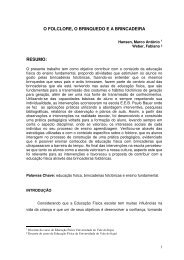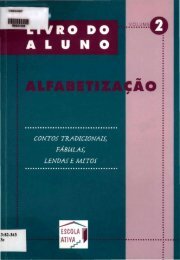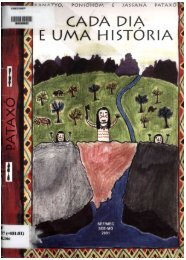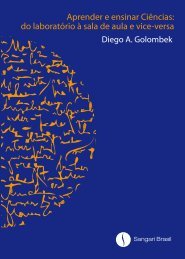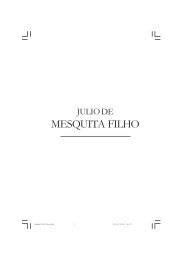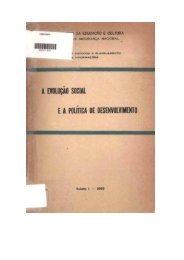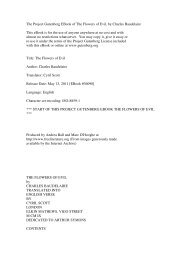A History of English Literature
A History of English Literature
A History of English Literature
Create successful ePaper yourself
Turn your PDF publications into a flip-book with our unique Google optimized e-Paper software.
Ireland, where in satirical poems he proceeded to attack the vanity <strong>of</strong> the<br />
world and the fickleness <strong>of</strong> men. His courtship and, in 1594, his marriage<br />
produced his sonnet sequence, called 'Amoretti' (Italian for 'Love-poems'),<br />
and his 'Epithalamium,' the most magnificent <strong>of</strong> marriage hymns in <strong>English</strong><br />
and probably in world-literature; though his 'Prothalamium,' in honor <strong>of</strong><br />
the marriage <strong>of</strong> two noble sisters, is a near rival to it.<br />
Spenser, a zealous Protestant as well as a fine-spirited idealist, was in<br />
entire sympathy with Lord Grey's policy <strong>of</strong> stern repression <strong>of</strong> the Catholic<br />
Irish, to whom, therefore, he must have appeared merely as one <strong>of</strong> the hated<br />
crew <strong>of</strong> their pitiless tyrants. In 1598 he was appointed sheriff <strong>of</strong> the<br />
county <strong>of</strong> Cork; but a rebellion which broke out proved too strong for him,<br />
and he and his family barely escaped from the sack and destruction <strong>of</strong> his<br />
tower. He was sent with despatches to the <strong>English</strong> Court and died in London<br />
in January, 1599, no doubt in part as a result <strong>of</strong> the hardships that he had<br />
suffered. He was buried in Westminster Abbey.<br />
Spenser's 'Faerie Queene' is not only one <strong>of</strong> the longest but one <strong>of</strong> the<br />
greatest <strong>of</strong> <strong>English</strong> poems; it is also very characteristically Elizabethan.<br />
To deal with so delicate a thing by the method <strong>of</strong> mechanical analysis seems<br />
scarcely less than pr<strong>of</strong>anation, but accurate criticism can proceed in no<br />
other way.<br />
1. _Sources and Plan_. Few poems more clearly illustrate the variety<br />
<strong>of</strong> influences from which most great literary works result. In many respects<br />
the most direct source was the body <strong>of</strong> Italian romances <strong>of</strong> chivalry,<br />
especially the 'Orlando Furioso' <strong>of</strong> Ariosto, which was written in the early<br />
part <strong>of</strong> the sixteenth century. These romances, in turn, combine the<br />
personages <strong>of</strong> the medieval French epics <strong>of</strong> Charlemagne with something <strong>of</strong><br />
the spirit <strong>of</strong> Arthurian romance and with a Renaissance atmosphere <strong>of</strong> magic<br />
and <strong>of</strong> rich fantastic beauty. Spenser borrows and absorbs all these things<br />
and moreover he imitates Ariosto closely, <strong>of</strong>ten merely translating whole<br />
passages from his work. But this use <strong>of</strong> the Italian romances, further,<br />
carries with it a large employment <strong>of</strong> characters, incidents, and imagery<br />
from classical mythology and literature, among other things the elaborated<br />
similes <strong>of</strong> the classical epics. Spenser himself is directly influenced,<br />
also, by the medieval romances. Most important <strong>of</strong> all, all these elements<br />
are shaped to the purpose <strong>of</strong> the poem by Spenser's high moral aim, which in<br />
turn springs largely from his Platonic idealism.<br />
What the plan <strong>of</strong> the poem is Spenser explains in a prefatory letter to Sir<br />
Walter Ralegh. The whole is a vast epic allegory, aiming, in the first<br />
place, to portray the virtues which make up the character <strong>of</strong> a perfect<br />
knight; an ideal embodiment, seen through Renaissance conceptions, <strong>of</strong> the<br />
best in the chivalrous system which in Spenser's time had passed away, but<br />
to which some choice spirits still looked back with regretful admiration.<br />
As Spenser intended, twelve moral virtues <strong>of</strong> the individual character, such<br />
as Holiness and Temperance, were to be presented, each personified in the<br />
hero <strong>of</strong> one <strong>of</strong> twelve Books; and the crowning virtue, which Spenser, in<br />
Renaissance terms, called Magnificence, and which may be interpreted as<br />
Magnanimity, was to figure as Prince (King) Arthur, nominally the central<br />
hero <strong>of</strong> the whole poem, appearing and disappearing at frequent intervals.<br />
Spenser states in his prefatory letter that if he shall carry this first<br />
projected labor to a successful end he may continue it in still twelve<br />
other Books, similarly allegorizing twelve political virtues. The<br />
allegorical form, we should hardly need to be reminded, is another heritage<br />
from medieval literature, but the effort to shape a perfect character,<br />
completely equipped to serve the State, was characteristically <strong>of</strong> the<br />
Platonizing Renaissance. That the reader may never be in danger <strong>of</strong>





